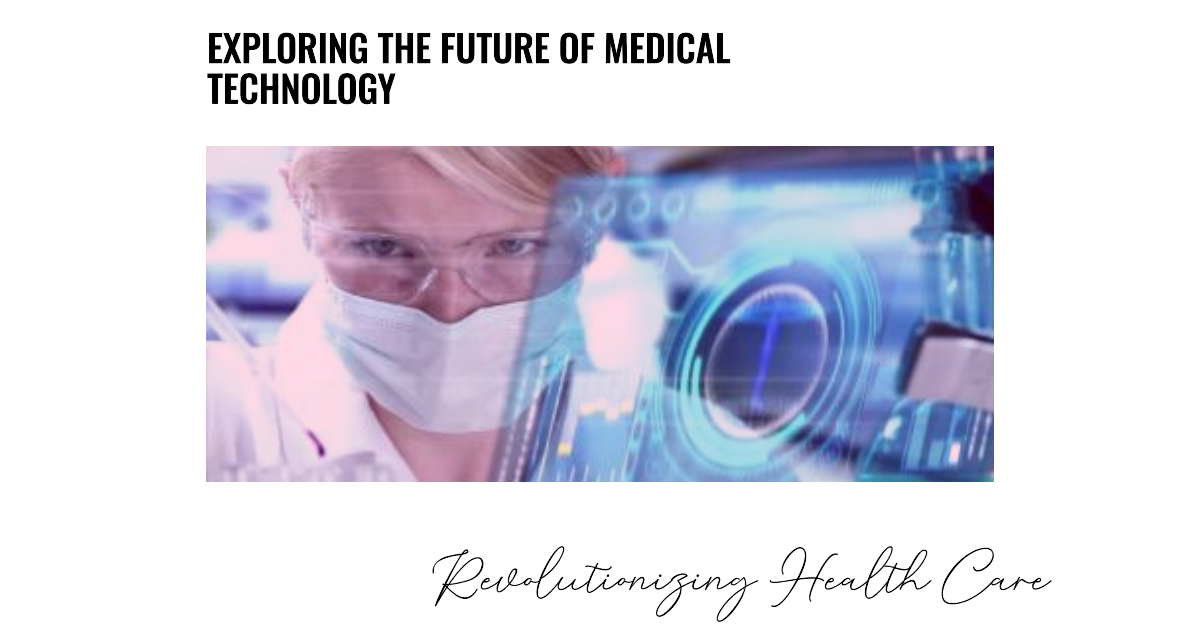
The future of health care medicine

The future of medicine in health care


The field of health care medicine in the future is a fascinating one that is rapidly developing. Revolutionary shifts in the delivery of health care are being brought about by advancements in technology, medical research, and patient care. The possibilities for enhancing patient outcomes and enhancing access to health care services are endless, and they range from personalized medicine to telemedicine. It is essential to remain up to date on the most recent developments in the health care sector as the industry continues to change. The current state of health care medicine will be discussed in this article, as will some exciting future possibilities.
Future Health Care Effects of Artificial Intelligence

The Effect of Man-made consciousness on Future Medical services
The coming of computerized reasoning (man-made intelligence) is changing how medical services is conveyed and made due. AI is a type of technology that lets machines do things like solve problems and make decisions like humans do. AI is being used in healthcare to assist in disease diagnosis and treatment, enhance patient care, and lower healthcare costs.
Computer based intelligence can possibly reform the medical services industry by giving more exact judgments, working on quiet consideration, and lessening medical services costs. AI enables healthcare providers to make better decisions regarding patient care by quickly and accurately analyzing large amounts of data. Additionally, AI can be utilized to provide individualized treatment plans and identify potential health risks.

Man-made intelligence can likewise be utilized to computerize ordinary errands, for example, booking arrangements and handling protection claims. This can assist with lessening regulatory expenses and let loose medical services suppliers to zero in on understanding consideration. Additionally, AI can be used to automate medical record keeping, enabling healthcare providers to quickly and accurately access and update patient data.

New therapies and treatments are also being developed with the help of AI. Simulated intelligence can be utilized to investigate a lot of information to recognize examples and patterns that can assist medical services suppliers with growing new therapies and treatments. Based on a patient’s past medical history and current health status, AI can also be used to create customized treatments.

AI has the potential to lower healthcare costs in addition to enhancing patient care. Automation is possible with AI.
The Job of Telemedicine in Future Medical services

In the health care industry, telemedicine is a rapidly expanding field that has the potential to transform the delivery of medical care. The practice of providing medical care to patients from afar via telecommunications technology is known as telemedicine. This innovation can possibly give a more proficient, practical, and helpful method for giving clinical consideration.

Later on, telemedicine will assume a significant part in giving medical care to those out of luck. Telemedicine can give admittance to clinical consideration to those living in provincial or far off regions, who might not approach a conventional medical services supplier. It can also make it possible for patients to get access to specialized care, like mental health care, that might not be available in their own neighborhood.

Telemedicine can likewise be utilized to give follow-up care to patients who have been released from the emergency clinic. This can assist with lessening readmission rates and work on quiet results. Patients who are unable to make it to the doctor’s office, such as those with mobility issues or those who live in remote areas, can also receive virtual visits through telemedicine.

People who might not be able to afford traditional health care can also get access to it through telemedicine. Telemedicine has the potential to aid in the reduction of health care costs and the expansion of access to health care for all by making medical care more affordable.

Future Health Care and the Application of Wearable Technology

The delivery of health care in the future could be completely transformed by the implementation of wearable technology. A type of technology that can be worn on the body and used to monitor, collect, and transmit health data is called wearable technology. Wearable innovation can be utilized to follow crucial signs, screen active work, and distinguish changes in the body that might demonstrate a medical problem.

The utilization of wearable technology in health care has the potential to both lower healthcare costs and enhance the standard of care provided. Wearable technology can identify changes in the body that may indicate a health issue before it becomes more serious by monitoring a person’s vital signs and physical activity. This early detection can help cut down on hospital visits and save money on more expensive treatments. Personalized health advice and reminders can also be provided by wearable technology to assist individuals in achieving their health objectives.

Health care delivery can also benefit from wearable technology. Wearable innovation can be utilized to screen a patient’s important bodily functions and actual work progressively, permitting medical services suppliers to settle on additional educated conclusions about therapy. Health care providers are able to monitor a patient’s health from a distance thanks to the use of wearable technology for remote monitoring. This can be particularly useful for individuals who live in distant regions or experience issues getting to medical care administrations.

The utilization of wearable innovation in medical services is still in its
The Capability of Quality Treatment in Future Medical services

One promising area of medical research is gene therapy, which has the potential to transform healthcare in the future. Utilizing genetic material to treat or prevent diseases is involved. It basically involves altering genes to treat or prevent a disease.

Gene therapy has a wide range of applications. It might be used to treat everything from cancer to genetic disorders. It could likewise be utilized to forestall illnesses, by acquainting qualities that are safe with specific sicknesses or conditions. Gene therapy could also be used to improve the quality of life of people with certain diseases, like cystic fibrosis or muscular dystrophy.

Quality treatment could likewise be utilized to foster new medicines for infections that are at present serious. Scientists may be able to develop treatments that could either cure or prevent diseases by introducing new genes into the body. This may be particularly beneficial for untreatable diseases like Alzheimer’s and Parkinson’s.

Quality treatment could likewise be utilized to work on the personal satisfaction for those impacted by hereditary problems. Scientists may be able to correct the disorder’s genetic defect by introducing new genes into the body. People with the disorder may see an improvement in their quality of life as a result of this.

Gene therapy could also be used to improve the quality of life for people with certain diseases, like cystic fibrosis or muscular dystrophy. Scientists introduce new genes into the body.

The Advantages of Accuracy Medication in Future Medical care

Accuracy medication is a progressive way to deal with medical care that is rapidly turning out to be more well known in the clinical field. It is a specialized approach to health care that takes into account a person’s lifestyle, environment, and genetic makeup. Instead of relying on a one-size-fits-all approach, doctors can use this strategy to tailor treatments and interventions to each patient’s specific requirements.

The advantages of accuracy medication are various. To begin, this strategy makes it possible to make diagnoses and treatments that are more precise. Physicians are able to more precisely determine the root cause of a medical condition and tailor treatments accordingly by taking into account an individual’s lifestyle, genetic makeup, and environmental factors. This can prompt more successful medicines, less secondary effects, and further developed results.

Furthermore, accuracy medication can likewise assist with diminishing medical care costs. Physicians are able to avoid prescribing unnecessary tests, medications, or treatments by customizing treatments to each patient’s specific requirements. As a result, patients may incur fewer costs and spend less time in the hospital.

At long last, accuracy medication can likewise prompt superior patient fulfillment. Physicians are able to provide more individualized care and enhance patient communication by taking into account the patient’s requirements. Patients may be happier as a result, and health outcomes may improve.

In general, the medical field is rapidly adopting precision medicine as the standard of care. The future of healthcare medicine is bright and full of potential by considering the individual’s unique requirements and providing more. Healthcare medicine is getting easier to access and more effective as technology and new treatments come to market. Individuals will be able to receive the best possible care as a result of the improved quality of care and the expanding availability of healthcare services. Additionally, healthcare providers will be able to better comprehend and meet the requirements of their patients by making use of predictive analytics and data-driven insights. As medical care medication keeps on developing, it is critical to remain informed and make the most of the open doors accessible to work on the wellbeing and prosperity of people.

Excerpt
The eventual fate of medical care medication is promising. With progresses in innovation, medicines and diagnostics are turning out to be more exact and productive. Personalized medicine is becoming more accessible, and new treatments for diseases that were previously untreatable are being developed. Patients’ outcomes will improve and their quality of life will improve as a result.

Get more access:–> https://sarbeshkblog.online ,https://sarbeshkblog.blogspot.com/















